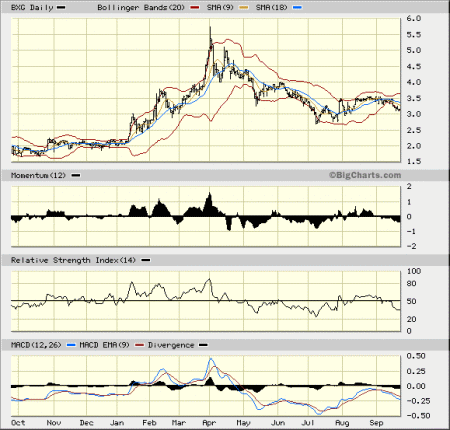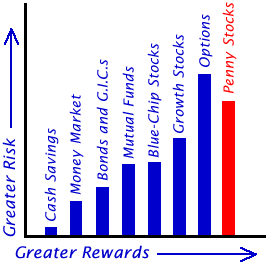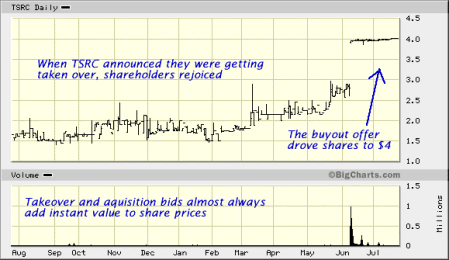


Get Instant Penny Stock Picks from the Authority!Visit www.PeterLeeds.com Right Now!
Technical analysis is the examination of the trading chart of a stock to look for trends, patterns, and hopefully predict future price direction. For these methods to work accurately, the underlying stock needs to have a high level of trading activity.
The high trading volumes in most large-cap, big name investments make technical analysis of the company's trading chart possible and improves the accuracy of those predictions.
Penny stocks lack the critical mass of trading volume to enable standard technical analysis. For the purposes of penny stock investors, I was forced to develop my own proprietary methods that could be applied to thinly traded securities. Read more about my opinion of penny stock technical analysis.

Above is an example of some of the Technical Analysis indicators that can be used to attempt to predict stock price direction.
While they have little bearing on the concepts presented in Understanding Penny Stocks, they are presented here as an example. Some of the idicators featured above include smooth moving average, bollinger bands, momentum, relative strength index, and others.
Side Note: I did not need to use all this fancy technical analysis to discover BXG (the stock featured above) just before it made its big move. Rather, I found BXG using Leeds Analysis and revealed it to my subscribers just before it multiplied in price.
Penny stocks can often undergo dramatic price swings, and often these moves can be on nothing more than a large buy or sell order. It is not unusual to see your shares drop or spike 20% or 50% or more during a trading day, and even return to their original starting point by the end of that same day.
When a company does come out with a significant press release, for example a biotech gaining FDA approval for its latest drug, expect the shares to make a big move, and even potentially build upon that advance the following few trading days. Price explosions of several hundred percent in a matter of hours or minutes are not uncommon.
Stock markets try to match up the highest bid price (to buy shares) and the lowest asking price (to sell shares). When these numbers match a trade takes place. For example, when you see a price quoted as $0.25, you know that the last trade was when a buyer and a seller both agreed upon $0.25 for their transaction.
At all times when the bid and ask are not matching, there is a spread. For example, if the highest bid is $0.80 and the lowest ask is $1.00, the spread between the two will be 20 cents.
You will quickly find that penny stocks are subject to much larger spreads (on a percentage basis) than more heavily traded stocks. It is common to see penny stocks with spreads of 15% to 30% when the buyers and sellers are not agreeing upon a price.
Penny stocks are considered higher risk, because uninformed or unlucky investors have lost money, and quickly.
Sometimes those losses are contained to a fraction of the invested capital, but other times traders lose 100% of their investment (for example, if the company goes bankrupt). Companies ceasing operations, running out of money, and / or closing their doors is much more common among penny stocks than other larger investments.
That is why it is so important to limit your risk, and avoid the common pitfalls that so many investors blindly fall into. Understanding Penny Stocks will help you limit your risk significantly.

It is not unlike driving. Driving will always be dangerous. So, drive a Volvo, the safest car, to protect yourself. Investing will always be dangerous. So, learn all about penny stocks to protect yourself.
Rewards are also much higher (potentially) than with other investment vehicles. Many penny stock companies have just started out, and will one day be huge corporations. The returns a trader could make off of one of these could be enough to live off of for years.
You can buy thousands of shares of penny stocks with a small investment. In contrast, it is not always within the means of an individual to purchase 100 shares of a $40 stock, which means that buying blue chip and large cap equity investments is not always realistic.
As well, if you do have a few thousand dollars it is easier to diversify among a group of penny stock companies, instead of buying only one or two more-expensive blocks of higher priced shares.
Most companies start off with an idea or business model, raise capital, and implement their operational strategy.
If they get this far, and many don't, they enter their growth phase. In this phase, their revenues go from nil to some level that (usually) is still not enough to meet their expenses.
The growth phase, when companies become discovered by the public and the financial industry, is when they usually enjoy the greatest share price movement.
As a company matures, they begin looking for additional complementary products and services to sell. They get their fiscal situation in order, turning those revenues into earnings, and may even pay dividends.
This process from new company to mature corporation takes years. Microsoft was once a two man operation, and they had an office sign that was scribbled on a piece of cardboard. They enjoyed an explosive and arguably the most dramatic growth phase in the history of the stock market, and now have hit maturity. They do not expect to keep advancing at their explosive rate, and are looking for alliances and ways to consolidate their industry position.
It is important to know that the majority of penny stocks are in the pre-revenue or very early growth stages. Many do not have revenues, and just as many have yet to prove that their concept or operational strategy has any merit.
Many penny stocks in this infancy stage are 'story stocks,' meaning that they have investor interest because of their potential. They have a great sounding 'story' or idea (for example, a new technology or drug that could revolutionize an industry), but have yet to prove it, or to show that they have a method to capture market share or educate society about their concept.
Watch this video to learn more about "story stocks," and the dangers.
Some larger companies, or those with higher cash flow, pay a portion of their cash to shareholders. Penny stocks, being cash-strapped and in their growth phase by their very nature as described above in 'the company life cycle,' generally do not.
However, it has happened from time to time. I once bought shares in a $0.14 penny stock, and the company decided to unload a large cash position that it had on its books. They paid out a one time dividend of $0.16, which by itself was higher than the original purchase price. (Note: Part of my personal justification for purchasing this company was that they had more cash on hand per share than the current trading price). I had more money than I had originally put in just from the dividend, and I still held the shares!
Since the market capitalization of a penny stock company is lower, they are excellent takeover targets for bigger players in the same field. As well, smaller penny stock companies often merge with one another as a way to increase sales and revenues in a bid to compete with or survive against the bigger industry players.

Generally, if a company is getting taken over their share price will benefit. If they are merging with another company, how the share price performs will depend on the situation, and could be beneficial or detrimental.